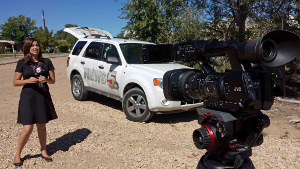


KOAA DELIVERS LIVE FLOOD FOOTAGE
COMPETING STATIONS DUB JVC'S GY-HM650 'MAGIC CAM'
KOAA,
the NBC affiliate for Colorado Springs-Pueblo, Colo. (DMA #89), used
the built-in live HD transmission functionality of its new GY-HM650
ProHD handheld mobile news camera to provide live coverage of
September's deadly Colorado floods. Wirelessly paired with a Verizon
Jetpack 4G LTE Mobile Hotspot, the HD camcorder was able to transmit
live footage during the event from locations that were inaccessible by
traditional live trucks.
For most live shots, KOAA relies on one of its three JVC GY-HM790
cameras, equipped with a KA-AS790G ASI module that is connected
directly to the microwave truck via BNC. However, many of the areas
affected by the floods did not provide line-of-sight to the station’s
tower, which meant microwave trucks could not be used. Satellite trucks
could work, but rising flood waters and muddy roadways made for
treacherous driving conditions.
According to Quentin Henry, KOAA chief engineer, the GY-HM650’s live
streaming functionality was pressed into service “so we could cover
these flood areas that could not be accessed by the live trucks.” The
station had just completed two days of streaming tests with a Teradek
decoder, which had been recently installed.
News teams took the GY-HM650 into canyons and other troubled areas to
document how quickly the water rose. Henry said the 720p footage from
the GY-HM650 was “one of the higher quality pictures we had on the air”
during the Colorado floods; the station’s Ku band satellite truck had
some breakup issues because its uplink path to the satellite was
obstructed by heavy cloud cover.
The camera’s dual codec design allowed KOAA to record its live standups
and other footage on an SDHC media cards on site in higher 1080p
resolution during its live shots. The news team was then able to edit
that footage into packages back at the station, without searching for a
copy of the broadcast. KOAA uses Harris Velocity NLE systems, and the
GY-HM650 records native .MP4 files that can be dropped directly into
the editing timeline without transcoding.
While KOAA has been broadcasting in HD since 2010 and has had a
tapeless workflow with Panasonic P2 camcorders for more than five
years, the station recently began the addition of JVC ProHD cameras.
“JVC popped up as a very solid, high quality player, with service equal
to if not above others,” Henry explained. Not only was JVC’s support of
live HD transmission a major selling point, but the company’s use of
inexpensive, non-proprietary SDHC media cards was “a huge issue when it
came to budgeting.”
KOAA is one of 10 television stations that are owned by Cordillera
Communications, Inc., and produce local news. Henry said the station
was used as a testbed for the GY-HM650 – and following its successful
use during the Colorado floods, another GY-HM650 was recently deployed
at KATC, the ABC affiliate serving Lafayette, La. (DMA #124). KOAA
photographers, who have been using the GY-HM650 since June, have
praised the camera’s light frame, sturdy build, and built-in 23x zoom
lens.
Since the floods, KOAA used the GY-HM650 for live coverage of
controversial city council meetings in Denver. Henry said shooters from
a major Denver-based network station began taking pictures of KOAA’s
“magic cam” because they were amazed that it could produce a live
transmission without a wired connection to a truck or a backpack video
transmission system.
Cordillera had previously researched the various backpack systems on
the market, but decided against investing in technology that required
multiple air cards for operation. “The JVC GY-HM650 and the Verizon
Jetpack have given us what we need,” Henry said. “We can do this with
only one Verizon data account instead of six to nine. That brings down
the cost considerably.”


